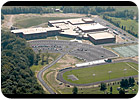
Each classroom at the new 274,952-sq-ft Highland Hills Middle School in Floyds Knobs, IN, has heat-monitoring sensors, and teachers have the ability to adjust each room by a 3° to 4°F range. When the temperature either rises above or below the loosely established outside air temperature 60°-changeover point, the BAS automatically switches the system over.
Floyd County faced a unique set of challenges when tasked with the design of a climate control system for the 274,952-sq-ft Highland Hills Middle School in Floyds Knobs, IN. The county had a limited budget, no access to natural gas, and only 1,540 sq ft had been dedicated to the facilities mechanical room. To overcome these obstacles, a hydronic two-pipe system operated on a propane-fired AERCO KC1000 boiler plant was implemented.
"Two-pipe systems cost less to build, take up less room, consume less energy and, because of their simplicity, are easier to maintain than the standard four-pipe system," said Bill Wiseheart, director of facilities for the Floyd County School District. "This is because they use half the piping, and half the number of pumps and actuators."
BAS PAVES THE WAY
Two-pipe designs require a switch from heating mode to cooling mode, and vice versa. In the past this could only be achieved via a difficult, labor-intensive process. But with today's modern BAS, the changeover can be both easy and fast."Our mechanical room contains eight 1-MBtuh KC1000 propane-fired boilers, two chillers, four system pumps with VFDs, two condensation pumps, an expansion tank, and a water softener with a brine tank," said Wiseheart. "Seven of the AERCO boilers are connected through AERCO's boiler management system, which is connected, along with everything else involved in the building's climate system, to our BAS. The eighth boiler is used exclusively to control the temperature of the school's swimming pool."
Each classroom has heat-monitoring sensors, and teachers have the ability to adjust each room by a 3° to 4°F range. When the temperature either rises above or below the loosely established outside air temperature 60°-changeover point, the BAS automatically switches the system over. The entire automated process takes only 20 min. The BAS will lock out the boiler system, actuate the single changeover valve from heating to cooling, and enable the chiller plant The BAS then monitors the water temperature as it cools. As it drops below room temperature, the BAS will change over the HVAC equipment from heating to cooling.
BRINGING COLD TO HOT
"Despite the ease of the automated switch, the frequency of changeovers has not been excessive," said Wiseheart. "ASHRAE standards maintain that the building must supply 15 cfm of outside air per student. This means that if the building is running a little hot, instead of switching the entire climate control system over to cooling, we can bring the temperature down a bit by venting in some of the cool outside air while still running the hydronic plant in heating mode.""When the loop is in heating mode, it runs at a maximum temperature of 120° and a minimum temperature of 80º," said Wiseheart. "The AERCO units are specifically designed to run at these low and frequently changing temperatures without any risk of thermal shock. This meant that the boilers could be installed directly onto the heating loop. And because the KC1000 boiler's combustion chamber and heat exchanger are constructed specifically to operate in condensing mode, the low water temperature of the hydronic loop is an asset that enables the AERCO units to operate more efficiently, increasing fuel savings while lowering operating costs."
By turning more of the boiler's fuel into usable heat, condensing within the heat exchanger increases efficiency by as much as 12%. This process occurs naturally when the water vapor, created as a by-product of the combustion process, cools below its dewpoint (~135°F). However, as the latent heat is extracted from the water vapor, a mild acid condensate remains on the surface of the heat exchanger. AERCO reports that the KC1000 units are designed to drain freely, alleviating this problem.
The Highland Hills Middle School opened its doors to students in August 2004 and the HVAC reviews have all been positive, along with the savings.
